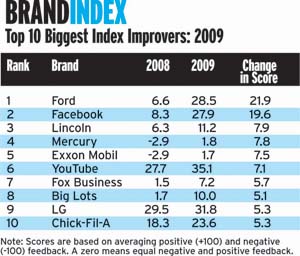 According to a BrandIndex poll, which based results on over 1.2 million online interviews throughout 2009, consumers voted Ford as the ‘most improved’ brand of the year. Based on those results, I guess it’s not surprising that Ford saw a 33% increase in sales in December, and Ford’s 2009 market share grew by 1% over 2008.
According to a BrandIndex poll, which based results on over 1.2 million online interviews throughout 2009, consumers voted Ford as the ‘most improved’ brand of the year. Based on those results, I guess it’s not surprising that Ford saw a 33% increase in sales in December, and Ford’s 2009 market share grew by 1% over 2008.
One of the reasons consumers might have a positive view of the Ford brand could be attributed to the company’s refusal to take money from the U.S. government’s TARP (Troubled Asset Relief Program) in 2009. Furthermore, the company made some overt attempts to adjust its product line to meet consumer needs rather than focusing on the ‘easy money’ sales automobile manufacturers had come to rely on in the 21st century.
Facebook ranked number two in the BrandIndex list of the most improved brands of 2009, and two more Ford-owned brands, Lincoln and Mercury, took the third and fourth spots. The top 10 most improved brands are shown in the image above.
BrandIndex also provides an annual consumer ranking of the ‘healthiest’ brands, which are defined as the brands that consumers perceive to be the strongest. Not surprisingly, brands like Google, Johnson & Johnson, M&M’s, Campbell’s, and other brands that people have learned to trust over the years ranked high in this list.
I’ve written about the importance of building brand trust here on Corporate Eye before, and the BrandIndex ranking supports that line of thinking. Without a doubt, consumers are looking for brands that offer transparency and trustworthiness in 2010 and the foreseeable future. At a time when consumer perceptions are easily shaped by the speed of social media conversations, brand managers have to work harder than ever to set, meet and exceed consumer expectations through every marketing touch point.
Consider Ford’s ranking on the BrandIndex list of the most improved brands of 2009. It’s unlikely anyone would have predicted that ranking a year ago. However, by setting consumer expectations (not taking the TARP money), meeting consumer expectations (revising the Ford product line), and exceeding expectations (let’s face it, expectations were low a year ago so Ford had a lot of opportunity to exceed them), word spread among consumers both through word-of-mouth marketing and social media conversations, and consumers began to see the brand as being more transparent and trustworthy than some of its competitors.
Take a look at your own business, consumers and competitors. Knowing that consumers want transparency and trustworthiness from the brands they choose, how can you capitalize on opportunities where you competitors are not delivering on those needs and create the perception that you can deliver on those needs.
Source: BrandWeek
Lucy is Editor at Corporate Eye


